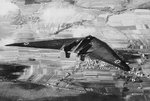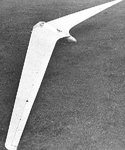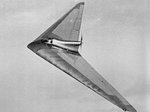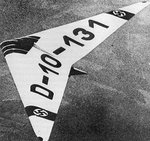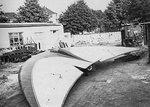Navigation
Install the app
How to install the app on iOS
Follow along with the video below to see how to install our site as a web app on your home screen.
Note: This feature may not be available in some browsers.
More options
You are using an out of date browser. It may not display this or other websites correctly.
You should upgrade or use an alternative browser.
You should upgrade or use an alternative browser.
German Flying wings
- Thread starter otftch
- Start date
Ad: This forum contains affiliate links to products on Amazon and eBay. More information in Terms and rules
More options
Who Replied?ThunderThud
Senior Airman
They have to be some of Hortens protoTypes.
GrauGeist
Generalfeldmarschall zur Luftschiff Abteilung
Those are prototypes of the Horton HoIX/229 aka Gotha Go229...
johnbr
2nd Lieutenant
They are the Ho226 aka V11 trainer one was made but is said that second one done but not assembled.
GrauGeist
Generalfeldmarschall zur Luftschiff Abteilung
Both photographs are of the Horton H VII.
It was a twin piston powered prop aircraft that flew successfully many times.
The Horton brothers were the masters of the flying wing, even Jack Northrop used alot of thier findings in his projects.
It was a twin piston powered prop aircraft that flew successfully many times.
The Horton brothers were the masters of the flying wing, even Jack Northrop used alot of thier findings in his projects.
The aircraft is a Horten Ho VII.
Wingspan : 16,00m
Length : 7,40m
Height : 2,60m
Empty weight: 2.200kg
MTOW : 3.200kg
Engine : 2x As 10C 240 hp
max speed : 340 km/h
cruise speed : 310 km/h
landing speed: 100 km/h
occupants : 2
first flight : may 1943 by Heinz Schneidhauer / Walter Horten
Wingspan : 16,00m
Length : 7,40m
Height : 2,60m
Empty weight: 2.200kg
MTOW : 3.200kg
Engine : 2x As 10C 240 hp
max speed : 340 km/h
cruise speed : 310 km/h
landing speed: 100 km/h
occupants : 2
first flight : may 1943 by Heinz Schneidhauer / Walter Horten
SoD Stitch
Banned
I never knew they'd built any reciprocating-powered wings, I've only ever seen the jet-powered versions.
Anybody know how the Go 229 at the Smithsonian is coming along? I haven't heard anything about it in quite a while . . . .
Anybody know how the Go 229 at the Smithsonian is coming along? I haven't heard anything about it in quite a while . . . .
Flyboy2
Senior Airman
I'm not quite sure but try this websight
Rare Aircraft - Germany
There is a few interesting flying wings
Rare Aircraft - Germany
There is a few interesting flying wings
GrauGeist
Generalfeldmarschall zur Luftschiff Abteilung
The Horton brothers had a huge collection of prototypes, starting with gliders and then piston powered versions, both single and tandem configurations.
They eventually came up with jet powered versions (as you know) that they are best remembered for.
I'll see if I can find images of most of the prototypes.
They eventually came up with jet powered versions (as you know) that they are best remembered for.
I'll see if I can find images of most of the prototypes.
GrauGeist
Generalfeldmarschall zur Luftschiff Abteilung
What about this one then? I never bought any subsequent issues, so I don't know if it was ever solved. (From "Aeroplane" August 1995)
Graeme, I'm not sure who the maker of that wing is...
It doesn't look like any design the Horton brothers were working on. Thier designs borrow heavily on the delta wing theory.
I looked through some of my notes, and it looks nothing like the Lippisch or Junkers flying wing designs. I also checked to see if it was one of the Russian designs (by B.I.Cheranovskiy), which it wasn't. It's clearly not anything of Jack Northrop's. But I'll keep looking around.
Anyway, here's some photos of the little known Horton flying wings, listed in order of design. I left out H VI since it was a arger version of H IV. And of course, I left out H VII, since it's pictured at the start of this thread
Also note how the Horton's Parabel took a slightly different approach to the flying wing concept, circa 1938.
1. H I
2. H II
3. H III
4. H IV
5. H V
6. Parabel (Parabola)
7. 8. Two photos of Ho XIII which was under developement at war's end. One of the two photos shows it in flight.
Just a footnote here: Every single one of these aircraft shown were not only capable of flight as a number of photos show, but they flew them many times and in some cases created as many as 5 variants of a particular type.
Attachments
I'm not quite sure but try this websight
Rare Aircraft - Germany
There is a few interesting flying wings
Thanks Flyboy2! Impressive site! It took about 10 minutes to download for me, but you have provided the answer...
But I'll keep looking around.
Good post Dave, very informative! Thanks for your effort. Have a look at the site Flyboy2 posted above. Close to the bottom you'll find the KHOEL KO-1, which until this evening, I have never seen or heard of before, and Googling reveals nothing (for me)...
Attachments
GrauGeist
Generalfeldmarschall zur Luftschiff Abteilung
I think we have some answers to the KHOEL KO-1 mystery!
Looking at the name KHOEL And the aparently German designation KO-1, I wondered if it might be misspelled because of the KO, so I tried Koehl and my hunch was correct...
And this is what I found:
The flying wing was built by Dr. Hermann Koehl and Ernst Von Loessl at the Weimar Engineering School in 1933. It first flew in 1934. Not sure how many times it flew, or if it crashed or not. (well, ok...in one of the pics posted, it had crashed, but I meant crashed as in total loss...)
The aircraft images you posted, Graeme, look to be from a September 1934 issue Dutch magazine by the name of "Vliegwereld".
The aircraft's specifications are:
Wingspan: 13,00 m
Overall Length: 4,50 m
Engine: Hirth HM 60 R-1 - 44,5 kw
Looks like there's only a few publications with light information and a few books that have additional information. Not much in the way of technical references to it, though.
Looking at the name KHOEL And the aparently German designation KO-1, I wondered if it might be misspelled because of the KO, so I tried Koehl and my hunch was correct...
And this is what I found:
On 12th/13th of April 1928 Hermann Koehl ( 1888-1938 ) became world famous when he, together with Major Fitzmaurice and Freiherr Guenther von Huenefeld, crossed the Atlantic Ocean from east to west by air for the first time in history. The aircraft they used was the specially modified Junkers W33 b "Bremen" (D-1167).
The flying wing was built by Dr. Hermann Koehl and Ernst Von Loessl at the Weimar Engineering School in 1933. It first flew in 1934. Not sure how many times it flew, or if it crashed or not. (well, ok...in one of the pics posted, it had crashed, but I meant crashed as in total loss...)
The aircraft images you posted, Graeme, look to be from a September 1934 issue Dutch magazine by the name of "Vliegwereld".
The aircraft's specifications are:
Wingspan: 13,00 m
Overall Length: 4,50 m
Engine: Hirth HM 60 R-1 - 44,5 kw
Looks like there's only a few publications with light information and a few books that have additional information. Not much in the way of technical references to it, though.
Flyboy2
Senior Airman
Thanks Flyboy2! Impressive site! It took about 10 minutes to download for me, but you have provided the answer...
Anytime.. If you ever go back to the rareaircraft home page at
Main Page @ rareaircraf1.greyfalcon.us you can see all sorts of cool aircraft. The German one is the longest though.
GrauGeist
Generalfeldmarschall zur Luftschiff Abteilung
Thanks Graeme, and I suppose the magazine didn't have the ww2aircraft forums around back then to fill in some blanks, huh? 
I figure since we've been discussing flying wings, I'd mention some others that were already developed or in development during the war.
One flying wing designer, Boris Cheranovskiy of the Soviet Union, had been developing flying wings since the early 20's. None of his designs reached mass production, and most were flyable one-off designs.
Another wing designer, was Alexander Lippisch. His works included a large number of pre-war gliders and designs. Lippisch's advanced delta designs influenced the Me163 Komet, the Horton Ho XIII and numerous aircraft designs decades later, including the Harrier VTOL. Hanna Reitsch personally test flew many of Lippisch's designs.
Junkers had a few designs, and some late war prototypes that looked to borrow from the Lippisch design. One was the EF-130 and a variant of the EF-130 which I have had trouble finding a true designation for. It was referred to as the EF-140, but seems to be confused with the Soviet built Ju-287 (EF-131) swept-wing bomber, the OKB EF 140.
Jack Northrop had been developing flying wings for years before the war, and successfully flew the N-1M in 1941. Subsequent models were the N-9M, YB-35 and YB-49 all designed or under develpment during the war.
And finally, Armstrong Whitworth had a flying wing being developed during the war. The AW.52 first flew as a glider in 1945, successfully flying under it's own power two years after the war.
I know there were many other "flying wing" designs that came out of the war, but those aren't true flying wings since they have tail structures with elevators or fuselages/booms.
The pictures are:
Shown at the top is the BICh-14, from 1935.
The next image is a Lippisch DFS-194, not a Me163.
This third image is "technically" the Junkers EF-140.
I figure since we've been discussing flying wings, I'd mention some others that were already developed or in development during the war.
One flying wing designer, Boris Cheranovskiy of the Soviet Union, had been developing flying wings since the early 20's. None of his designs reached mass production, and most were flyable one-off designs.
Another wing designer, was Alexander Lippisch. His works included a large number of pre-war gliders and designs. Lippisch's advanced delta designs influenced the Me163 Komet, the Horton Ho XIII and numerous aircraft designs decades later, including the Harrier VTOL. Hanna Reitsch personally test flew many of Lippisch's designs.
Junkers had a few designs, and some late war prototypes that looked to borrow from the Lippisch design. One was the EF-130 and a variant of the EF-130 which I have had trouble finding a true designation for. It was referred to as the EF-140, but seems to be confused with the Soviet built Ju-287 (EF-131) swept-wing bomber, the OKB EF 140.
Jack Northrop had been developing flying wings for years before the war, and successfully flew the N-1M in 1941. Subsequent models were the N-9M, YB-35 and YB-49 all designed or under develpment during the war.
And finally, Armstrong Whitworth had a flying wing being developed during the war. The AW.52 first flew as a glider in 1945, successfully flying under it's own power two years after the war.
I know there were many other "flying wing" designs that came out of the war, but those aren't true flying wings since they have tail structures with elevators or fuselages/booms.
The pictures are:
Shown at the top is the BICh-14, from 1935.
The next image is a Lippisch DFS-194, not a Me163.
This third image is "technically" the Junkers EF-140.
Attachments
johnbr
2nd Lieutenant
Henk
Master Sergeant
For more reading and pics.
http://www.ww2aircraft.net/forum/aircraft-requests/horton-brothers-flying-wings-3618.html
http://www.ww2aircraft.net/forum/aircraft-requests/horton-brothers-flying-wings-3618.html
evangilder
"Shooter"
Northrop only built 4 N9M testbeds (essentially flying models in scale for the bombers). Only once survives today, the N9MB owned by the Planes of Fame in Chino. The project to restore the aircraft took 25 years and included retired Northrop engineers. There were no diagrams for it, so everything was from memory and from trial and error. The Franklin engines used for the N9M are also very rare. There are only three known to exist, with 2 of them in the aircraft. From what I understand, the third one is incomplete. They did buy spare pistons when they needed them after the engine fire several years ago and fortunately, it is flying again.




RabidAlien
1st Lieutenant
Always loved the clean lines and look of the flying wings...those planes seem to be begging for open skies! The bright yellow, though....just seems odd. Great pics, as always, Eric! 
Users who are viewing this thread
Total: 1 (members: 0, guests: 1)




